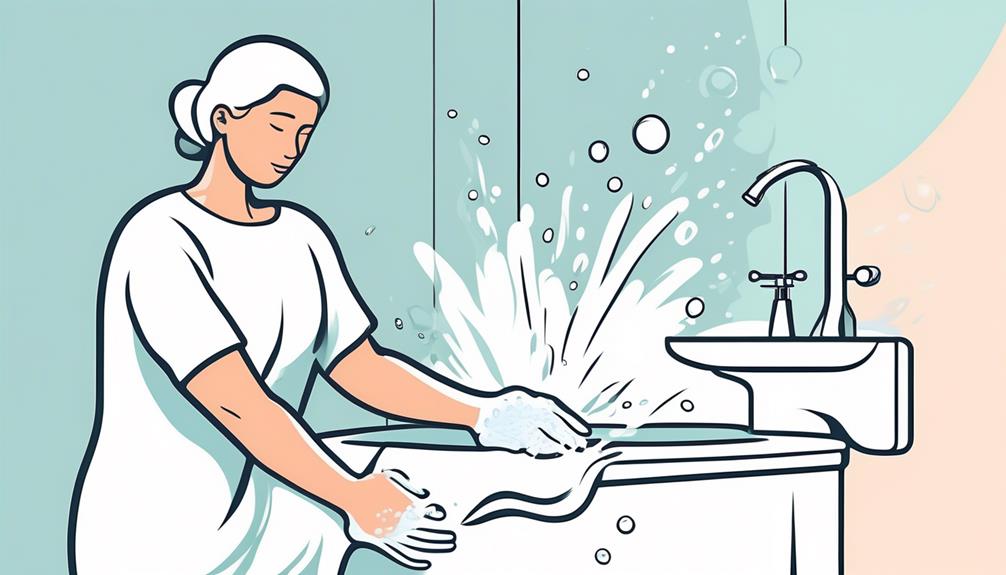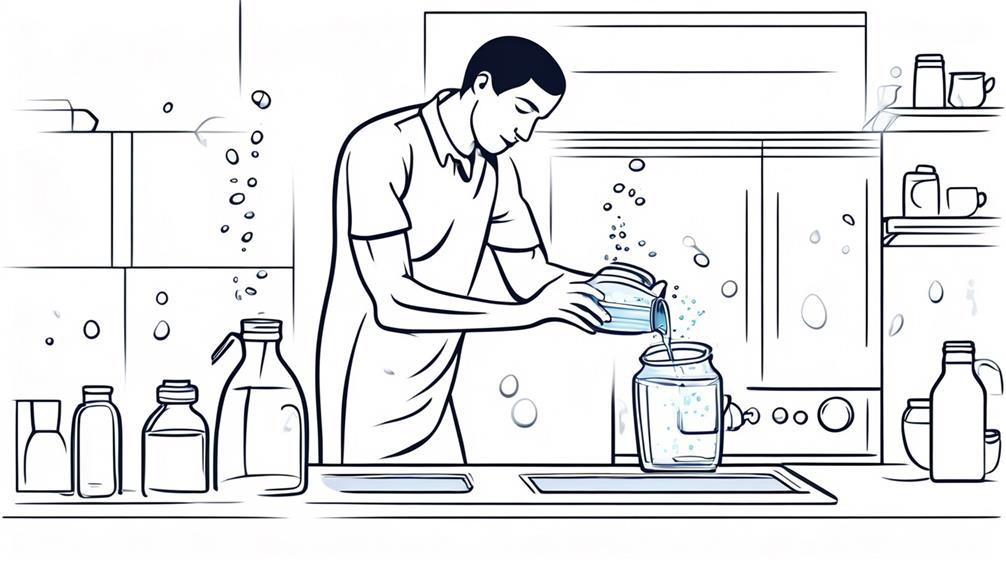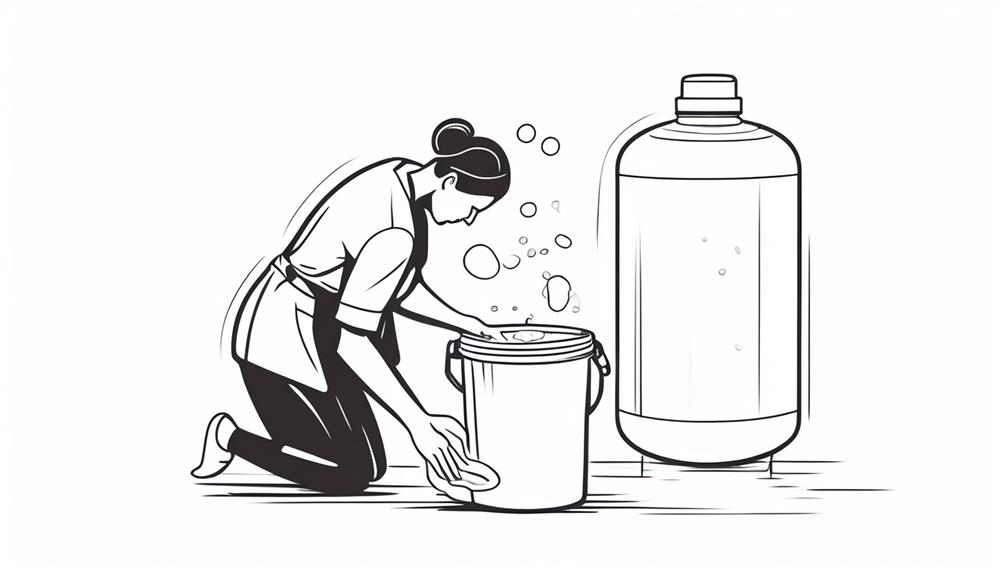Imagine your body as a fortress, with waterborne diseases lurking outside its gates, waiting for a chance to invade. Just like you wouldn't leave your castle unprotected, you shouldn't leave yourself vulnerable to these unseen threats.
By following simple yet effective strategies, you can fortify your defenses and keep these illnesses at bay.
So, how can you ensure your fortress remains impregnable against waterborne foes?
Key Takeaways
- Boil water or use purification tablets to kill pathogens and ensure safe drinking water.
- Stay informed about water quality reports and avoid swimming in polluted waters to prevent exposure to harmful bacteria.
- Install water filtration systems at home for clean and healthy drinking water, improving taste and removing impurities.
- Practice good hygiene habits, including washing hands regularly and maintaining cleanliness in water storage containers, to prevent waterborne diseases.
Boil Water Before Consuming
Before drinking water, always remember to boil it to ensure it's safe for consumption. Boiling water is a simple yet effective way to kill harmful bacteria, parasites, and viruses that may be present. By bringing the water to a rolling boil for at least one minute, you can significantly reduce the risk of waterborne diseases such as diarrhea, cholera, and typhoid fever.
When water is boiled, the heat destroys pathogens that can cause illness, making the water safe to drink. This method is particularly crucial when you're unsure about the quality of the water source, especially while camping, traveling, or during emergencies. Remember, boiling water is a reliable way to protect yourself and your family from potentially dangerous contaminants.
Make it a habit to boil water before using it for drinking, cooking, or brushing your teeth. Investing a few minutes in boiling water can save you from the discomfort and health risks associated with contaminated water. Stay proactive and prioritize your health by making boiling water a non-negotiable step in your daily routine.
Use Water Purification Tablets
Consider using water purification tablets to easily and effectively safeguard against waterborne diseases. Water purification tablets are a convenient and reliable way to ensure the water you consume is safe for drinking, especially when you are unsure about its quality. These tablets are compact, lightweight, and easy to use, making them ideal for travelers, hikers, or emergency situations.
| Pros | Cons |
|---|---|
| Convenient and easy to use | May leave a slight aftertaste |
| Lightweight and portable | Not as effective against all contaminants |
| Effective against various pathogens | Limited shelf life |
| Can treat large volumes of water | Some tablets require wait time |
To use water purification tablets, simply follow the instructions provided with the product. Typically, you would add the tablet to the specified amount of water, wait for the recommended time, and then you will have safe drinking water. Remember that while water purification tablets are a great tool, they may not be as effective against certain types of contaminants, so it's essential to have other water treatment methods available as well.
Install Filtration Systems at Home
Want to ensure your tap water is clean and safe to drink? Install filtration systems at home to filter out impurities and contaminants.
By purifying your drinking water, you can significantly reduce the risk of waterborne diseases.
Take control of your water quality by investing in a reliable filtration system today.
Filter Tap Water
Upgrade your home by installing a reliable filtration system to ensure the purity of your tap water and safeguard against waterborne diseases. Water filters can effectively remove impurities like bacteria, parasites, and harmful chemicals, providing you with clean and safe drinking water.
By filtering your tap water, you reduce the risk of contracting illnesses such as diarrhea, cholera, and typhoid fever caused by contaminated water sources. Additionally, filtration systems can improve the taste and odor of your water, making it more enjoyable to drink and cook with.
Take control of your water quality by investing in a filtration system for your home, ensuring that you and your family stay healthy and hydrated.
Purify Drinking Water
To ensure the purity of your drinking water and protect against waterborne diseases, consider installing a reliable filtration system in your home. By doing so, you can effectively eliminate harmful contaminants and pathogens that may be present in your water supply.
Filtration systems work by trapping impurities, such as bacteria, viruses, chemicals, and sediments, ensuring that the water you consume is clean and safe. There are various types of filtration systems available, ranging from simple pitcher filters to more advanced under-the-sink or whole-house systems.
Choose a system that best suits your needs and budget to provide you and your family with a constant supply of fresh, purified water. Invest in your health and well-being by purifying your drinking water at home.
Avoid Swimming in Polluted Waters
Swimming in polluted waters can pose serious health risks due to the presence of harmful bacteria and contaminants. To avoid potential waterborne diseases, follow these strategies:
- Check Water Quality: Before swimming, check if the water has been tested for pollutants. Look for any warning signs or advisories posted by local authorities.
- Choose Designated Swimming Areas: Opt for designated swimming areas like pools or beaches with lifeguards. These areas are often monitored and maintained to ensure water quality.
- Avoid Swimming After Heavy Rain: Rain can wash pollutants into water bodies, increasing contamination levels. It's best to avoid swimming for a few days after heavy rainfall.
- Shower After Swimming: After swimming in any water body, make sure to shower with soap. This helps remove any bacteria or contaminants that may have come in contact with your skin.
Practice Proper Hand Hygiene

Proper hand hygiene is essential in preventing the spread of waterborne diseases and maintaining overall health. Washing your hands with soap and clean water before eating, after using the restroom, and after any contact with potentially contaminated water is crucial. By doing so, you can eliminate harmful bacteria and viruses that could make you sick.
Remember, even if the water looks clean, there might still be invisible germs present. Therefore, always carry a small bottle of hand sanitizer with you when you're out and about near water sources. It's a convenient way to disinfect your hands when soap and water aren't readily available.
Additionally, avoid touching your face with unwashed hands, as this can introduce pathogens into your body. Keeping your hands clean is a simple yet effective way to protect yourself from waterborne illnesses. So, make it a habit to prioritize proper hand hygiene, especially when you're in environments where water quality may be questionable.
Stay Updated on Water Quality Reports
Maintaining good hand hygiene is crucial to ward off waterborne diseases; therefore, staying updated on water quality reports is equally important to ensure you're aware of potential risks in the water sources you encounter.
Here are four key reasons why staying updated on water quality reports is essential:
- Early Detection: Regularly checking water quality reports allows you to spot any contamination issues promptly, enabling you to take necessary precautions.
- Avoidance of Contaminated Sources: By staying informed about water quality in your area, you can steer clear of potentially contaminated water bodies or sources.
- Protecting Your Health: Being aware of the quality of water you're in contact with helps in safeguarding yourself and your loved ones from waterborne illnesses.
- Government Advisories: Water quality reports often include any government advisories or alerts, which can provide crucial information on current water conditions and risks.
Drink Bottled or Boiled Water

When it comes to safeguarding your health from waterborne illnesses, there are several important steps to remember:
- Filtering tap water
- Using water purifiers
- Maintaining water cleanliness
Filter Tap Water
To ensure safe drinking water, consider filtering your tap water or opt for bottled or boiled water. Filtering tap water can help remove impurities and contaminants, providing you with a cleaner and healthier option. Here are some benefits of filtering your tap water:
- Removes Harmful Substances: Filters can eliminate various harmful substances like lead, chlorine, and bacteria.
- Improves Taste: Filtering can enhance the taste and odor of water, making it more pleasant to drink.
- Cost-Effective: Investing in a water filter is usually more cost-effective in the long run compared to constantly buying bottled water.
- Environmental Impact: Using a filter reduces plastic waste from disposable water bottles, contributing to a cleaner environment.
Use Water Purifiers
ARTICLE TITLE: Strategies to Ward Off Waterborne Diseases
PREVIOUS SUBTOPIC: 'Filter Tap Water'
CURRENT SUBTOPIC: 'Use Water Purifiers'
Considering the benefits of filtering tap water, now let's explore the option of using water purifiers such as drinking bottled or boiled water for added safety against waterborne diseases.
When it comes to safeguarding your health against waterborne illnesses, opting for purified water is a smart choice. Both bottled and boiled water offer an extra layer of protection by eliminating harmful pathogens. Below is a comparison table to help you decide which option suits you best:
| Criteria | Bottled Water | Boiled Water |
|---|---|---|
| Convenience | High | Moderate |
| Cost | High | Low |
| Effectiveness | Guaranteed | Effective |
Maintain Water Cleanliness
For enhanced water cleanliness, consider incorporating bottled or boiled water into your daily routine. By opting for these safer alternatives, you can reduce the risk of waterborne diseases significantly.
Here are some key points to keep in mind:
- Bottled Water: Ensure that the bottled water you purchase is from a reputable source and hasn't been tampered with.
- Boiled Water: Boil water for at least one minute to kill off any harmful bacteria or parasites that may be present.
- Storage: Store bottled water in a cool, dry place away from direct sunlight to maintain its quality.
- Emergency Preparedness: Always have a supply of bottled water or a means to boil water in case of emergencies or natural disasters.
Keep Water Storage Containers Clean

Regularly cleaning water storage containers is essential for preventing the growth of harmful bacteria and ensuring the purity of the water you consume. Neglecting to clean these containers can lead to the accumulation of dirt, mold, and bacteria, which can contaminate your drinking water and put your health at risk.
To keep your water storage containers clean, follow these simple steps:
First, wash your containers with hot, soapy water after each use. Make sure to scrub all surfaces, including the lid and any spigots, to remove any residue or buildup. Rinse thoroughly to remove all soap residue.
Second, sanitize your containers regularly. Use a mixture of one teaspoon of bleach per gallon of water to disinfect the containers. Allow the solution to sit for a few minutes, then rinse thoroughly with clean water.
Lastly, ensure proper storage of your containers. Keep them covered and in a clean, dry area away from potential contaminants. By following these steps, you can help maintain the cleanliness of your water storage containers and safeguard the quality of your drinking water.
Wash Fruits and Vegetables Thoroughly
When preparing your meals, make sure to clean your fruits and vegetables thoroughly. By removing dirt and germs, you can prevent food contamination and protect yourself from waterborne diseases.
Take the extra step to wash your produce properly to ensure your meals are safe and healthy.
Clean Produce Properly
To ensure your safety and health, always thoroughly wash fruits and vegetables before consumption. When it comes to cleaning produce properly, follow these steps:
- Rinse: Start by rinsing fruits and vegetables under running water to remove dirt and debris.
- Scrub: For produce with thicker skins like potatoes or carrots, use a brush to scrub the surface and remove any remaining dirt.
- Soak: Consider soaking produce like leafy greens in a bowl of water to loosen any contaminants that may be present.
- Dry: After washing, make sure to dry the produce with a clean paper towel or cloth to further reduce the risk of bacterial contamination.
Remove Dirt and Germs
Properly washing fruits and vegetables is essential to remove dirt and germs, safeguarding your health and well-being. Before consuming or cooking produce, take a moment to rinse them thoroughly under running water.
Use a vegetable brush for items with tougher skins, like potatoes or carrots, to ensure all dirt and bacteria are removed. Remember to wash even fruits and vegetables with peels or rinds, as cutting into them can transfer contaminants to the flesh.
Avoid using soap or bleach, as they can leave residue on the produce. By making it a habit to wash your fruits and vegetables diligently, you reduce the risk of ingesting harmful pathogens and enjoy a healthier diet overall.
Prevent Food Contamination
Ensure the safety of your food by thoroughly washing fruits and vegetables to prevent contamination. When it comes to preventing foodborne illnesses, this simple step can make a big difference. Here are some tips to help you wash your produce effectively:
- Use clean running water: Rinse fruits and vegetables under running water to remove dirt and bacteria.
- Scrub with a brush: For items with thick or rough skins, like melons or potatoes, use a brush to scrub and remove any residues.
- Dry with a clean cloth: Pat fruits and vegetables dry with a clean cloth or paper towel to further remove any lingering bacteria.
- Store properly: After washing, store fruits and vegetables in a clean container to prevent recontamination.
Educate Yourself on Water Safety
Learn about water safety practices to protect yourself from waterborne diseases. Understanding how to stay safe around water sources is crucial in preventing illnesses. Start by recognizing the signs of contaminated water, such as unusual color, odor, or floating debris. Always opt for clean, treated water whenever possible to reduce your risk of exposure to harmful pathogens. If you're unsure about the water quality, consider using water purification methods like boiling, filtering, or using water purification tablets.
Additionally, be mindful of where you swim or engage in water activities. Avoid stagnant water bodies, as they're more likely to harbor disease-causing organisms. When swimming in natural water sources, such as lakes or rivers, check for any local advisories or warnings. Remember to never swallow water while swimming and to shower after being in contact with untreated water.
Frequently Asked Questions
Can Waterborne Diseases Be Transmitted Through Contact With Contaminated Surfaces?
Yes, waterborne diseases can be transmitted through contact with contaminated surfaces. Always ensure proper hygiene practices, like washing hands regularly, sanitizing surfaces, and avoiding contact with contaminated water sources to reduce the risk.
How Often Should Water Storage Containers Be Cleaned to Prevent Waterborne Diseases?
To prevent waterborne diseases, clean water storage containers regularly. Aim for cleaning them at least every few weeks. This practice helps eliminate any potential contamination, ensuring your water remains safe for consumption.
Are There Any Specific Fruits or Vegetables That Are More Prone to Carrying Waterborne Pathogens?
When selecting produce, be cautious with leafy greens, melons, and berries, which can be prone to carrying waterborne pathogens. Wash them thoroughly to reduce risks. Enjoy your meals safely by practicing good food hygiene.
Is It Necessary to Use Both Water Purification Tablets and Boil Water Before Consumption, or Is One Method Sufficient?
You should always use both water purification tablets and boil water before consumption. Combining these methods ensures that you eliminate any potential waterborne pathogens, keeping you safe and healthy. It's better to be cautious.
How Can Individuals in Areas With Poor Water Quality Access Reliable Information on Water Safety and Quality Reports?
When checking water safety in questionable areas, seek local health departments, online resources, or community organizations for water quality reports. Remember, "knowledge is power," so stay informed to protect yourself from waterborne illnesses.
Conclusion
In conclusion, by boiling water before consuming, using purification tablets, and installing filtration systems at home, you can effectively ward off waterborne diseases.
Remember to avoid swimming in polluted waters, practice proper hand hygiene, and drink bottled or boiled water.
Keep water storage containers clean, wash fruits and vegetables thoroughly, and educate yourself on water safety.
Taking these simple steps will help keep you and your loved ones safe and healthy.
